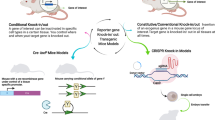Abstract
Progress in our understanding of the molecular cellular basis of immune function depends on our ability to track and image individual immune cells in vivo. To this end, the development of mouse models over-expressing various fluorescent proteins would represent an important experimental tool. In this report, we describe the generation and characterization of pUbi-mRFP-1 transgenic mice, in which the monomeric form of red fluorescent protein is ubiquitously expressed in various lymphoid and non-lymphoid tissues. Our newly generated pUbi-mRFP-1 mice are unique among previously reported mice transgenic for red fluorescent proteins because a single-copy of the mRFP-1 transgene driven by human ubiquitin C promoter has been integrated by homologous recombination into the mouse hypoxanthine-guanine phosphoribosyltransferase (HPRT) locus. We show that the distinct and uniform levels of mRFP-1 expression allow easy identification of transferred hematopoetic cells by FACS analysis or confocal microscopy, even when the transferred population represents a very small proportion in the target organ. Also, even in long-term experiments, we have seen no evidence of rejection of transferred pUbi-mRFP-1 lymphocytes. Due to its far-red spectrum, mRFP-1 is an ideal partner for dual imaging with green fluorescent proteins. We observed a good visual separation between donor lymphocytes derived from either mRFP-1 or eGFP transgenic mice in recipient animals. Our study suggests that the new pUbi-mRFP-1 transgenic mouse strain offers new opportunities for studying cellular interactions and migratory patterns of cells, especially for dual imaging of different cell types. In summary, our results demonstrate that a controlled strategy of transgenesis provides an effective means of ubiquitously expressing fluorescent proteins in vivo.





Similar content being viewed by others
References
Baird GS, Zacharias DA, Tsien RY (2000) Biochemistry, mutagenesis, and oligomerization of dsred, a red fluorescent protein from coral. PNAS 97:11984–11989
Bevis BJ, Glick BS (2002) Rapidly maturing variants of the discosoma red fluorescent protein (dsred). Nat Biotech 20:83–87
Brassinga AKC, Marczynski GT (2001) Replication intermediate analysis confirms that chromosomal replication origin initiates from an unusual intergenic region in caulobacter crescentus. Nucleic Acids Res 29:4441–4451
Bronson SK, Plaehn EG, Kluckman KD, Hagaman JR, Maeda N, Smithies O (1996) Single-copy transgenic mice with chosen-site integration. PNAS 93:9067–9072
Campbell RE, Tour O, Palmer AE, Steinbach PA, Baird GS, Zacharias DA et al (2002) A monomeric red fluorescent protein. PNAS 99:7877–7882
Cvetkovic B, Yang B, Williamson RA, Sigmund CD (2000) Appropriate tissue- and cell-specific expression of a single copy human angiotensinogen transgene specifically targeted upstream of the hprt locus by homologous recombination. J Biol Chem 275:1073–1078
Denarier E, Forghani R, Farhadi HF, Dib S, Dionne N, Friedman HC et al (2005) Functional organization of a schwann cell enhancer. J Neurosci 25:11210–11217
Farhadi HF, Lepage P, Forghani R, Friedman HCH, Orfali W, Jasmin L et al (2003) A combinatorial network of evolutionarily conserved myelin basic protein regulatory sequences confers distinct glial-specific phenotypes. J Neurosci 23:10214–10223
Hadjantonakis A-K, Macmaster S, Nagy A (2002) Embryonic stem cells and mice expressing different GFP variants for multiple non-invasive reporter usage within a single animal. BMC Biotechnol 2:11
Hadjantonakis A-K, Nagy A (2000) Facs for the isolation of individual cells from transgenic mice harboring a fluorescent protein reporter. Genesis 27:95–98
Lock LF, Takagi N, Martin GR (1987) Methylation of the hprt gene on the inactive × occurs after chromosome inactivation. Cell 48:39–46
Maniatis T, Fritsch EF, Sambrook J (1982) Molecular cloning: A laboratory manual. Cold Spring Harbor Laboratory Press, Cold Spring Harbor, NY
Matz MV, Fradkov AF, Labas YA, Savitsky AP, Zaraisky AG, Markelov ML et al (1999) Fluorescent proteins from nonbioluminescent anthozoa species. Nat Biotech 17:969–973
Meisler MH (1992) Insertional mutation of ‘classical’ and novel genes in transgenic mice. Trends Genet 8:341–344
Schaefer BC, Schaefer ML, Kappler JW, Marrack P, Kedl RM (2001) Observation of antigen-dependent cd8+ t-cell/dendritic cell interactions in vivo. Cell Immunol 214:110–122
Shaner NC, Campbell RE, Steinbach PA, Giepmans BNG, Palmer AE, Tsien RY (2004) Improved monomeric red, orange and yellow fluorescent proteins derived from Discosoma sp. Red fluorescent protein. Nat Biotechnol 22:1567–1572
van der Sar AM, Musters RJP, van Eeden FJM, Appelmelk BJ, Vandenbroucke-Grauls CMJE, Bitter W (2003) Zebrafish embryos as a model host for the real time analysis of Salmonella typhimurium infections. Cell Microbiol 5:601–611
Verkhusha VV, Otsuna H, Awasaki T, Oda H, Tsukita S, Ito K (2001) An enhanced mutant of red fluorescent protein dsred for double labeling and developmental timer of neural fiber bundle formation. J Biol Chem 276:29621–29624
Vintersten K, Monetti C, Gertsenstein M, Zhang P, Laszlo L, Biechele S et al (2004) Mouse in red: red fluorescent protein expression in mouse ES cells, embryos, and adult animals. Genesis 40:241–246
Vivian J, Klein W, Hasty P (1999) Temporal, spatial and tissue-specific expression of a myogenin-lacz transgene targeted to the Hprt locus in mice. Biotechniques 27:154–162
Wan YY, Flavell RA (2005) Identifying Foxp3-expressing suppressor T cells with a bicistronic reporter. PNAS 102: 5126–5131
Zhu H, Wang G, Li G, Han M, Xu T, Zhuang Y et al (2005) Ubiquitous expression of mRFP1 in transgenic mice. Genesis 42:86–90
Acknowledgements
We are grateful for the McGill Flow Cytometry Facilities for their effort in cell sorting. We would like to thank the meticulous assistance provided by Patrick Bastedo and Dr. Gregory T. Marczinsky, as well as the technical support of the animal care staff at the McGill Animal Center. We acknowledge the financial support of the Canadian Institutes for Health Research (CIHR MOP 67211) and Canadian Foundation for Innovation. E.Y. is a recipient of a fellowship from the CIHR Training Grant in Neuroinflammation. C.A.P is the recipient of the Canada Research Chair in Regulatory Lymphocytes of the Immune System.
Author information
Authors and Affiliations
Corresponding author
Rights and permissions
About this article
Cite this article
Yurchenko, E., Friedman, H., Hay, V. et al. Ubiquitous expression of mRFP-1 in vivo by site-directed transgenesis. Transgenic Res 16, 29–40 (2007). https://doi.org/10.1007/s11248-006-9030-6
Received:
Accepted:
Published:
Issue Date:
DOI: https://doi.org/10.1007/s11248-006-9030-6




